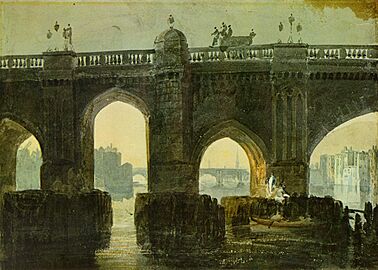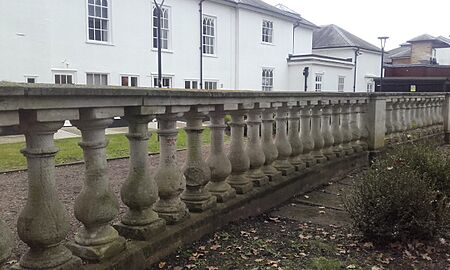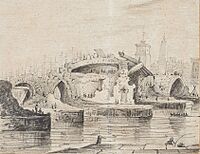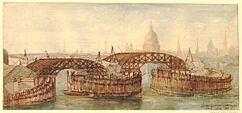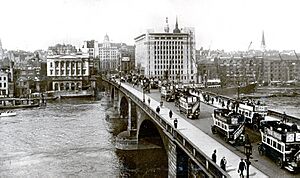London Bridge facts for kids
Quick facts for kids London Bridge |
|
|---|---|

London Bridge in 2017
|
|
| Coordinates | 51°30′29″N 0°05′16″W / 51.50806°N 0.08778°W |
| Carries | Five lanes of the A3 |
| Crosses | River Thames |
| Locale | Central London |
| Maintained by | Bridge House Estates, City of London Corporation |
| Preceded by | Cannon Street Railway Bridge |
| Followed by | Tower Bridge |
| Characteristics | |
| Design | Prestressed concrete box girder bridge |
| Total length | 269 m (882.5 ft) |
| Width | 32 m (105.0 ft) |
| Longest span | 104 m (341.2 ft) |
| Clearance below | 8.9 m (29.2 ft) |
| Design life |
|
| History | |
| Opened | 16 March 1973 |
London Bridge is the name for several bridges that have stood in the same spot over the River Thames in central London. These bridges have connected the City of London and Southwark since Roman times. The bridge you see today opened in 1973. It is a modern concrete and steel bridge.
This current bridge replaced an older stone bridge from the 1800s. Before that, there was a stone bridge that stood for 600 years! For much of its history, the old medieval bridge had many homes and shops built right on top of it. The very first London Bridge was made of wood. It was built by the Romans around 50 AD.
The modern London Bridge is located at the western end of the Pool of London. It is about 30 metres (98 ft) upstream from where the older bridges used to be. For a long time, until 1729, London Bridge was the only road crossing over the Thames in London. London Bridge has appeared in many famous artworks, books, and songs. One well-known example is the nursery rhyme "London Bridge Is Falling Down".
An independent charity called Bridge House Estates owns and takes care of the modern bridge. This charity has been around since medieval times. The bridge carries the A3 road, which is looked after by the Greater London Authority.
Contents
History of London Bridge
Where London Bridge Stands
The modern London Bridge is built on natural banks of gravel, sand, and clay. For thousands of years, the southern bank was a natural path above the surrounding marshy land. The northern bank rose to higher ground. Between these banks, people could cross the River Thames by walking across at low tide or by ferry when the tide was high. Both banks were good spots for boats to land. The Thames River was a major trade route for Britain and Europe from ancient times.
There is evidence of early settlements nearby from the Stone Age, Bronze Age, and Iron Age. But the city of London itself did not exist until a bridge was built there. The Romans built the first London Bridge as part of their plan to take over Britain.
Roman Bridges in London
It is possible that Roman army engineers built a temporary bridge around 43 AD. Any bridge would have made it faster to travel overland to Colchester, which was an important Roman city. The Roman roads leading to London were probably built around 50 AD. A permanent wooden bridge likely followed soon after.
A small trading settlement grew on the dry ground at the northern end of the bridge. This settlement became the city of Londinium. A smaller settlement also grew on the southern side, in the area now called Southwark. The bridge might have been destroyed in a revolt around 60 AD, but Londinium was rebuilt. It eventually became the main city of Roman Britain. The bridge allowed people, horses, and carts to move easily across the Thames. It connected major roads from the north and south. Near the bridge were large docks for ships trading with the rest of the Roman Empire.
Early Medieval Bridges
After the Romans left Britain in the 5th century, Londinium was slowly abandoned. The bridge fell apart. In the Anglo-Saxon period, the river became a border between different kingdoms. By the late 800s, Viking invasions led to the Saxons moving back into the area. The bridge might have been rebuilt by Alfred the Great or later by King Æthelred the Unready to help move his troops.
A story tells of the bridge being destroyed in 1014 by Æthelred's ally, Olaf, to split up the Danish forces. The first written record of a Saxon bridge is from around 1016. Chroniclers mentioned how Cnut's ships went around the bridge during his war.
After the Norman conquest in 1066, King William I rebuilt the bridge. It was repaired or replaced by King William II. A fire destroyed it in 1136, and it was rebuilt again. In 1163, Peter of Colechurch oversaw the last rebuilding of the bridge in timber.
Old London Bridge (1209–1831)
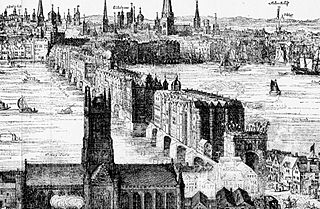
After the death of Thomas Becket, the Archbishop of Canterbury, King Henry II ordered a new stone bridge to be built. It would have a chapel in the middle dedicated to Becket. Building started in 1176, led by Peter of Colechurch. The costs were huge. People later told a story that London Bridge was built on wool, because taxes on wool helped pay for it.
Construction was finished in 1209. Houses were built on the bridge from the start. This was a common way to pay for bridge upkeep. The bridge was about 926 feet (282 metres) long. It had nineteen stone arches and a wooden drawbridge. There were strong structures around the piers to protect them. The bridge, including the houses, was about 20 to 24 feet (6.1 to 7.3 metres) wide. The road itself was usually around 15 feet (4.6 metres) wide.
The many structures around the piers made the river's flow very narrow. The water level could be as much as 6 feet (1.8 m) different on each side. This created dangerous rapids between the piers. Only very brave or foolish people tried to steer a boat under the bridge. Many drowned trying. People said the bridge was "for wise men to pass over, and for fools to pass under." The narrow flow also meant the river upstream froze more easily in cold winters.
The number of houses on the bridge reached its highest in the late 1300s, with 140 homes. Over time, many smaller houses were combined. By 1605, there were 91 houses. Most houses had four or five floors. Many had a shop on the ground floor, living areas on the first floor, and a kitchen on the second. About half the houses had a "cross building" that linked houses on both sides of the bridge above the road.
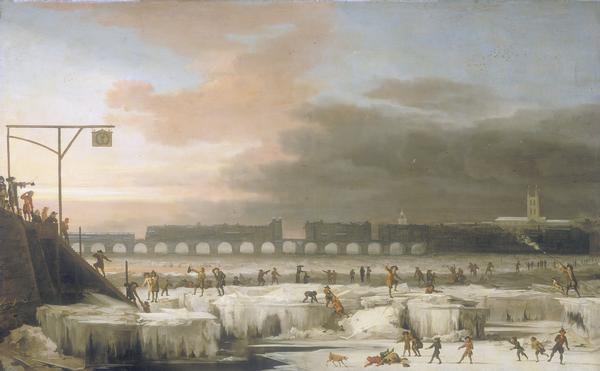
All the houses were shops. The bridge was one of London's main shopping streets. Many shopkeepers sold fabrics, gloves, knives, and bows. Later, more traders sold textiles, groceries, and other goods like books.
The three main buildings on the bridge were the chapel, the drawbridge tower, and the stone gate. The chapel was rebuilt in the late 1300s. After the Reformation, it became a house in 1553. The drawbridge stopped opening in the 1470s. In 1577–1579, the tower was replaced by Nonsuch House, a magnificent pair of houses.
The stone gate was rebuilt in the 1470s. It became famous for displaying the heads of traitors. The heads were dipped in tar and boiled to preserve them. They were then placed on spikes. The head of William Wallace was the first recorded in 1305. Other famous heads included Thomas More and Thomas Cromwell. In 1598, a visitor counted over 30 heads on the bridge. The last head was placed there in 1661.
In 1578–1582, a Dutchman named Peter Morris built a waterworks at the north end of the bridge. Water wheels under the arches powered pumps that sent water into the city. In 1591, water wheels were also installed at the south end to grind corn.
In 1633, a fire destroyed houses on the northern part of the bridge. This created a gap that stopped the Great Fire of London (1666) from spreading to the rest of the bridge and Southwark. The Great Fire also destroyed the bridge's waterwheels, which meant they couldn't pump water to fight the fire.
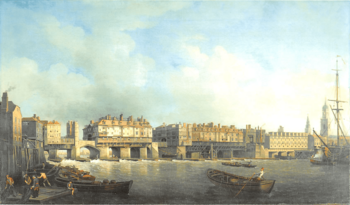
For nearly 20 years, only temporary sheds replaced the burnt buildings. In the 1680s, almost all the houses on the bridge were rebuilt. The road was widened to 20 feet (6.1 metres). The new houses extended further over the river, which caused problems later. In 1695, 551 people lived on the bridge. From 1722, traffic was told to keep to the left. This might be one reason why traffic in Britain now drives on the left.
A fire in 1725 destroyed houses on the south side. The last houses built on the bridge were designed in 1745. But these buildings started to sink within ten years. In 1756, the City Corporation was given power to buy and demolish all the properties on the bridge to improve it. While this work was happening, a temporary wooden bridge was built. It opened in 1757 but burned down the next year. The old bridge was reopened until a new temporary one was ready. To help boats pass, the two middle arches were replaced by one wider arch in 1759.
The demolition of the houses was finished in 1761. The last person living on the bridge moved out after about 550 years of homes being there. The road was widened to 46 feet (14 m). A decorative railing and 14 stone shelters for pedestrians were added. However, creating the large arch had weakened the bridge. Constant expensive repairs were needed. This, along with traffic jams, led to public demand for a new, modern bridge.
-
London Bridge from Pepper Alley Stairs by Herbert Pugh, showing the bridge after 1762, with the new "Great Arch" at the centre.
-
Old London Bridge by J. M. W. Turner, showing the new railing and the back of one of the pedestrian shelters.
-
A section of railing from London Bridge, now at Gilwell Park in Essex.
-
A relief of the Hanoverian Royal Arms from a gateway over the old London Bridge now forms part of the façade of the King's Arms pub, Southwark.
New London Bridge (1831–1967)
In 1799, a competition was held to design a replacement for the medieval bridge. Thomas Telford suggested a single iron arch. But his design would have needed very wide roads leading to it, which meant buying and tearing down expensive buildings nearby.
Instead, a more traditional design with five stone arches by John Rennie was chosen. It was built about 100 feet (30 m) west (upstream) of the old bridge. Work started in 1824. The first stone was laid on 15 June 1825.
The old bridge stayed in use while the new one was being built. It was torn down after the new bridge opened in 1831. New roads leading to the bridge had to be built. These roads cost three times as much as the bridge itself. The total cost was around £2.5 million. This cost was shared by the British Government and the City of London.
Rennie's bridge was 928 feet (283 m) long and 49 feet (15 m) wide. It was made from granite. The official opening was on 1 August 1831. King William IV and Queen Adelaide attended a special dinner on the bridge. The northern road leading to the bridge was renamed King William Street after the king.
By 1896, the bridge was the busiest spot in London. About 8,000 pedestrians and 900 vehicles crossed it every hour. It was widened by 13 feet (4.0 m). Later checks showed that the bridge was sinking about an inch (2.5 cm) every eight years. By 1924, the east side had sunk about three to four inches (9 cm) lower than the west side. The bridge would need to be removed and replaced.
Selling the Bridge
A member of the City of London Council, Ivan Luckin, suggested selling the bridge. He said people thought he was "completely crazy" at the time. In 1968, the Council put the bridge up for sale. On 18 April 1968, an American businessman named Robert P. McCulloch bought Rennie's bridge for US$2,460,000. The story that McCulloch thought he was buying the more famous Tower Bridge was denied by Luckin.
Before the bridge was taken apart, each granite block was marked so it could be put back together.
10,000 tons of granite blocks were shipped through the Panama Canal to California. Then they were trucked to Arizona. The blocks were used to cover a new, strong concrete structure. This made sure the bridge could handle modern traffic. The bridge was rebuilt at Lake Havasu City, Arizona. It was officially opened again on 10 October 1971. London's Lord Mayor and celebrities attended the ceremony. The bridge now carries McCulloch Boulevard and crosses an artificial waterway in Lake Havasu City.
Modern London Bridge (1973–present)
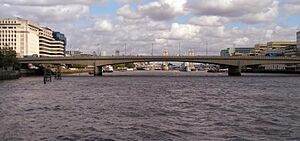
The current London Bridge was designed by Lord Holford and engineers Mott, Hay and Anderson. It was built from 1967 to 1972. Queen Elizabeth II opened it on 16 March 1973. It has three sections made of strong concrete. It is a total of 833 feet (254 m) long. The cost of £4 million was paid entirely by the Bridge House Estates charity.
The current bridge was built in the same place as Rennie's bridge. The old bridge stayed in use while the first two sections of the new bridge were built. Then traffic moved onto the new sections. The old bridge was then torn down to allow the final two central sections to be added.
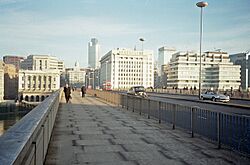
In 1984, the British warship HMS Jupiter crashed into London Bridge. Both the ship and the bridge were damaged.
On Remembrance Day 2004, several bridges in London were lit up with red lights. London Bridge was the only one that kept its lights on permanently. They are now regularly switched on at night.
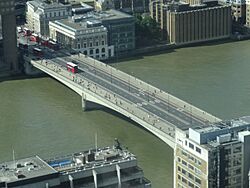
The current London Bridge often appears in films and documentaries. It is shown with many commuters traveling to work in the City of London. For example, actor Hugh Grant crosses the bridge in the 2002 film About a Boy.
On 11 July 2008, to celebrate the 800th anniversary of Old London Bridge, the Lord Mayor of London and other officials drove a flock of sheep across the bridge. This was done to remember an old tradition.

After a terrorist attack on the bridge in 2017, security barriers were put in place. These barriers help protect pedestrians from the road.
Getting Around London Bridge
The closest London Underground stations are Monument, at the northern end of the bridge, and London Bridge at the southern end. London Bridge station also has National Rail train services.
See also
 In Spanish: Puente de Londres para niños
In Spanish: Puente de Londres para niños
- List of Roman bridges
- Roman bridge
- List of crossings of the River Thames
- List of bridges in London





